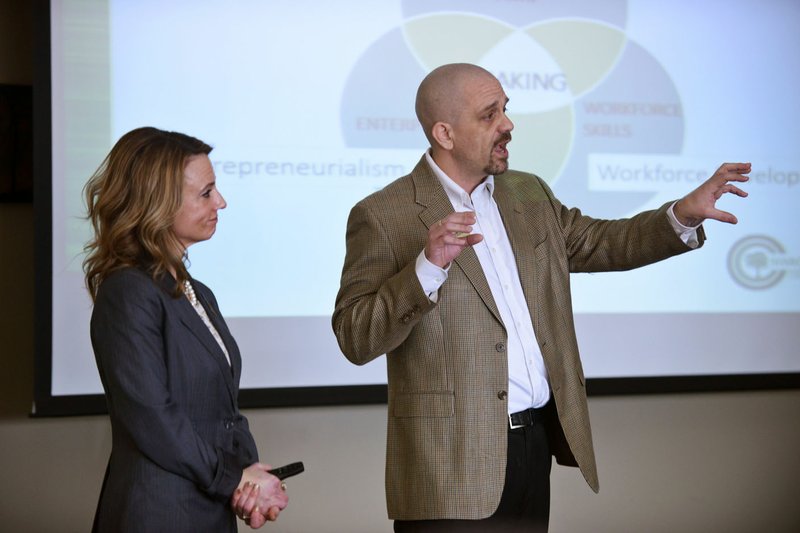BENTONVILLE -- Northwest Arkansas Community College administrators presented their vision Saturday of a new multi-purpose building to serve students pursuing degrees as well as those in noncredit, workforce training programs.
The latest plan for the facility represents a dramatic shift from an idea officials rolled out less than two months ago for a building dedicated solely to arts education.
Washington County center
Northwest Arkansas Community College is planning to build a permanent facility in Springdale that would offer a more convenient option for its students in Washington County. The college has the land next to Arvest Ballpark; the college’s foundation is working on raising money to build the facility. The foundation has raised $3.6 million toward a goal of $15 million. Evelyn Jorgenson, college president, said she’d like to break ground on the project later this year, but would like to get at least 75 percent of the money raised first.
Source: Staff report
Since then, administrators have discussed the project with various people, including state legislators, said Evelyn Jorgenson, college president.
"We listened to what people had to say and went back to the drawing board," Jorgenson said, addressing the Board of Trustees during its retreat meeting Saturday.
The building -- described as an integrated design lab -- would sit just west of the Becky Paneitz Student Center in the middle of campus. It probably would cost between $4 million and $4.5 million, Jorgenson said.
Keith Peterson, dean of the college's Workforce and Economic Development Department, and Megan Bolinder, dean of the Communications and Arts Division, explained the benefits of the revised plan.
The facility would offer spaces that could be used both by students in arts classes and those taking certain industrial training programs. Both types of offerings have similar space, power and ventilation needs, Peterson said.
"So if the school does this concept, then you can knock out space needs for two programs without having to design them twice," Peterson said.
More than that, however, they said the space would serve as a model of integrating artistry, technical skills and entrepreneurialism.
The integrated design space would develop students and future workers "who do more than fill employment needs, but who also respond to needs, imagine, create, build, and thus solve for and make our future, together," Bolinder said.
The college needs space where students can not only manipulate materials, but also learn about the business of marketing those goods. Art faculty members could infuse entrepreneurial ideas into their curriculum and craft, Bolinder said.
The state is emphasizing workforce preparation programs more than ever, Peterson said. The proposed facility is an opportunity for the college to expand its capacity in workforce training by integrating a traditional program of study, he said.
"And we feel like that's an enhancement of both worlds," Peterson said. "Now you're giving noncredit students exposure to the degree side of the house and you're giving traditional-degree students an opportunity to explore opportunities beyond what they just have in the classroom and more workforce-related fields. The common space, the design component of this, where we have facilities that are useful to both the fine arts and workforce, provides a home for that to happen."
In any case, the college needs additional space, Jorgenson said.
The college was spending nearly $300,000 per year to lease space in Rogers for its adult education program before moving that program to the main campus in 2015. That move saved the college money, but also put a squeeze on its space.
"So we really are very tight. The quickest way to add space on campus is to develop this relatively small building," Jorgenson said.
The money would come from the college's capital millage account. One-third of the millage dollars the college collects each year goes into that account and cannot be used for anything other than capital projects.
"That's as good a use of that money as anything we can do," Jorgenson said.
Todd Schwartz, a trustee, urged caution before moving forward on another building project. He mentioned the college's decline in enrollment over the past several years and other expenses the college has planned.
"We don't want to get ourselves into a situation where we're jeopardizing the sustainability of the college with additional expenses that might not be able to be covered," Schwartz said.
The college's Land Use and Facilities Committee approved the original plan for the facility as an arts-focused building by an 8-1 vote on Nov. 30, thus sending it to the board for approval.
Trustees, upon hearing the revised proposal Saturday, seemed to agree it should go back to the committee because of how much it has changed.
The additional space would allow the college to expand enrollment, Peterson said.
"We don't have anymore space to expand the programs we want to expand," he said. "You can put workforce right at the top of that list of programs that have nowhere else to go. We want more enrollment."
Todd Kitchen, the college's vice president of student services, said enrollment for the spring semester is at 105 percent of the college's goal. Enrollment as of Saturday was 7,174 students. They are taking a total of 65,752 credit hours, he said.
Friday was the fourth day of classes of the spring semester. On the 11th day of classes last spring semester, the college had 7,181 students taking 63,169 credit hours.
NW News on 01/22/2017


